

Gerry found the photographs that he had from World War II. He was in the 258th Field Artillery Battalion, mostly in France and Germany.
There were 12 guns in the Battalion. The Battalion was made up of 3 Batteries: A, B, and C (Charlie). Each battery had 4 guns. Each gun had it's crew (including a sergeant who drove the gun). In addition, each battery had a wire section. Gerry was on the wire section of Battery C.
Here is a link to a study that was done on communication in the European Theater. An interesting quote from it: "Colonel 3, Conn Anderson, War Department Observer, in Army Ground Force Report Number 283, stated that from his personal observation of the duties being performed in combat by enlisted personnel of field artillery, he was convinced that the wire crews were having the hardest and most difficult work to do."
I believe that the officers were as follows:
Before most pictures will be a brief summary by me. Following the picture will be, if available, correspondence from my Mom, in talking to Gerry, elaborating on the picture. Towards the bottom of the page is some additional general information.
One with 4 men in front of a tree. In France, late October. These are 4 men in his battalion. First on the left is Lemke, a member of the wire section of Charlie (C) battery. Second from the left is Shiro, a gun man in the battery (worked on one of the guns). Third from left is Sergeant Costello, the Captain's driver. On the right is Gerard J. Morin.
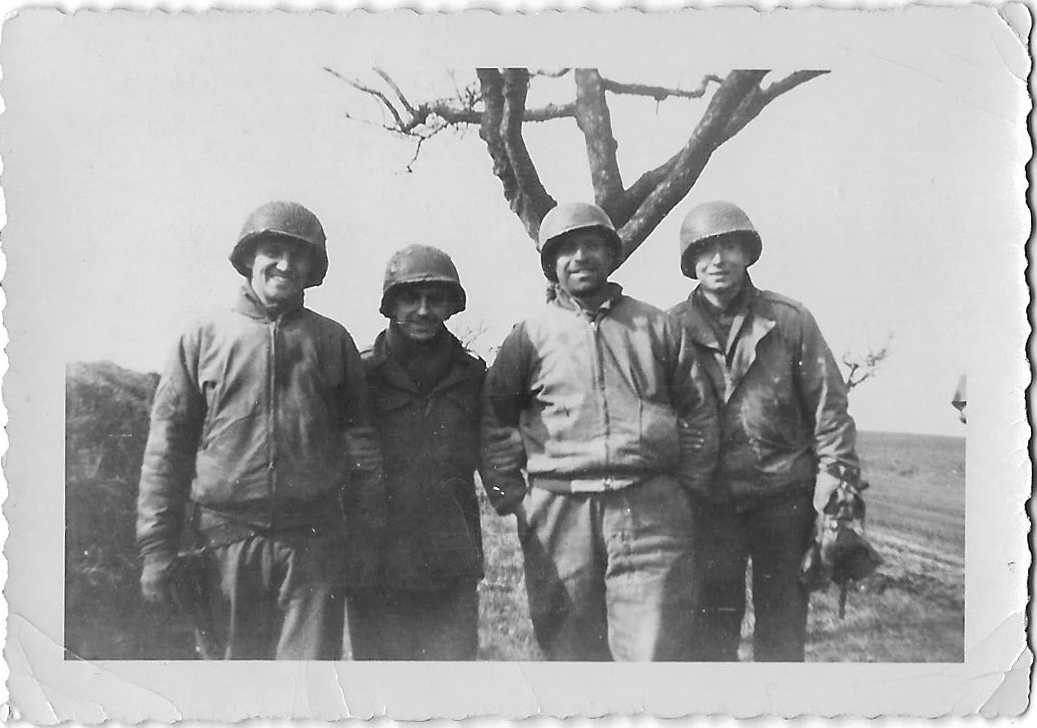
Picture of 5 men in front of the barren tree in France, late October. From left to right: Lieutenant Schuman (head of Battery C), Shiro, Sgt Costello (Cpt Foncellino's driver), the soldier who played harmonica (see later picture), Gerry.
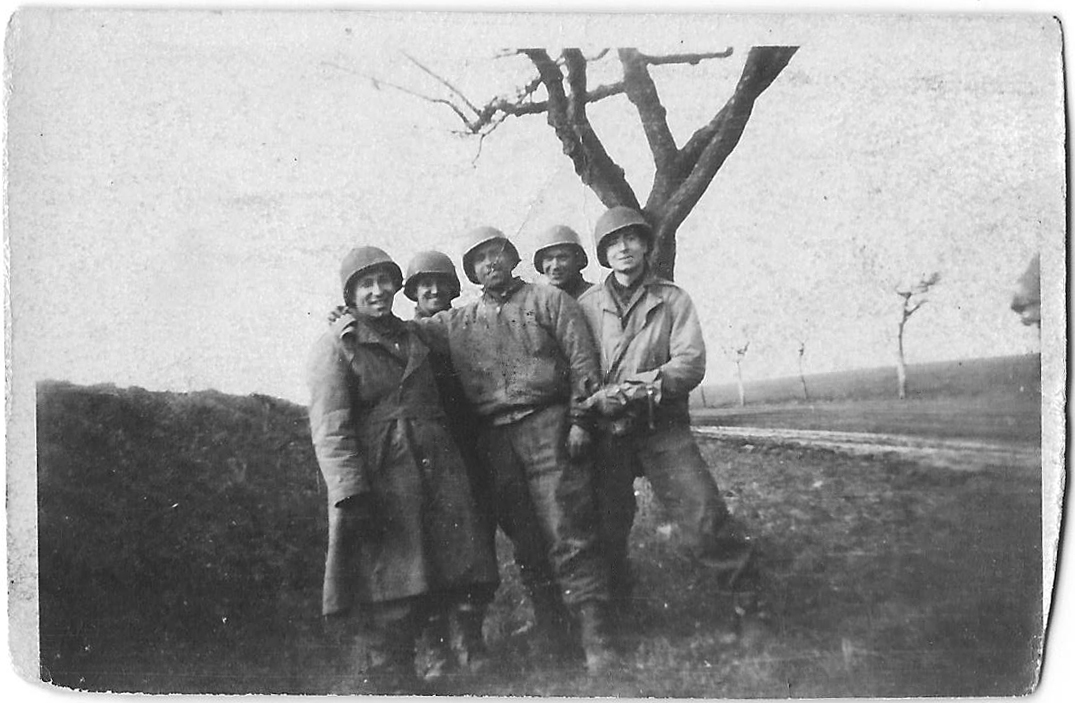
Photo on a muddy road while they were traveling through France. This is the Wire Section's truck pulling the trailer. Fall, with the barren trees. This was the convoy moving from one battle to another.
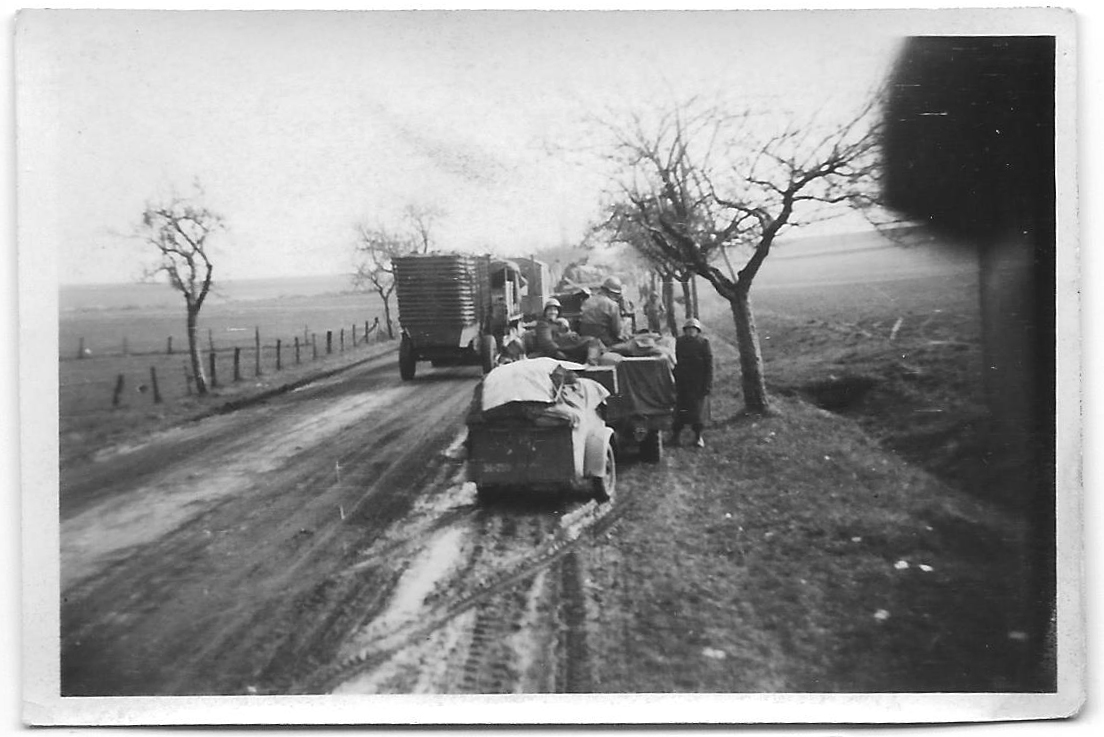
Photo of 2 men in front of the "6x6" troop carrier truck, in Alsfeld. The railroad station is in the background. Corporal Widermann, head of Battalion C Wire Section (radio transmission group) is on the left; Gerry is on the right. Gerry's battalion was stationed in the Alsfeld area for 5 months after the war ended, during the occupation. This was the last place he was deployed (last place stationed).
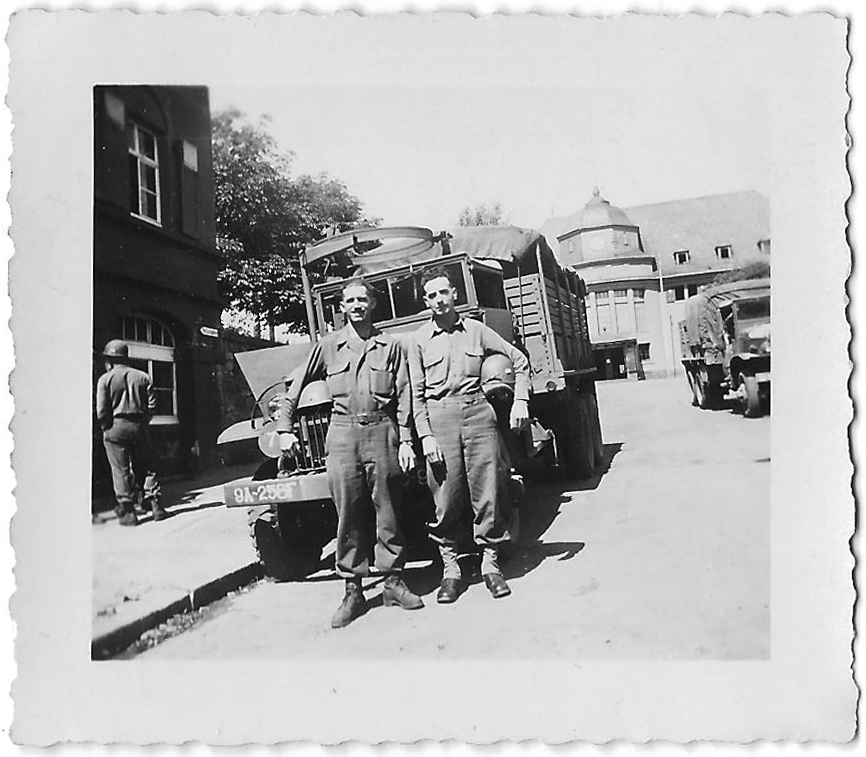
Traveling in France. Picture of the 4 men of the C-Battery Wire section in the back of a troop carrier. Gerry is on the left, towards the back. Next person is playing the harmonica; can't remember his name but he was from Pennsylvania, a substitute person like Gerry was for this New York based crew. The 3rd person is O'Riley (smoking). Far right is Kline.
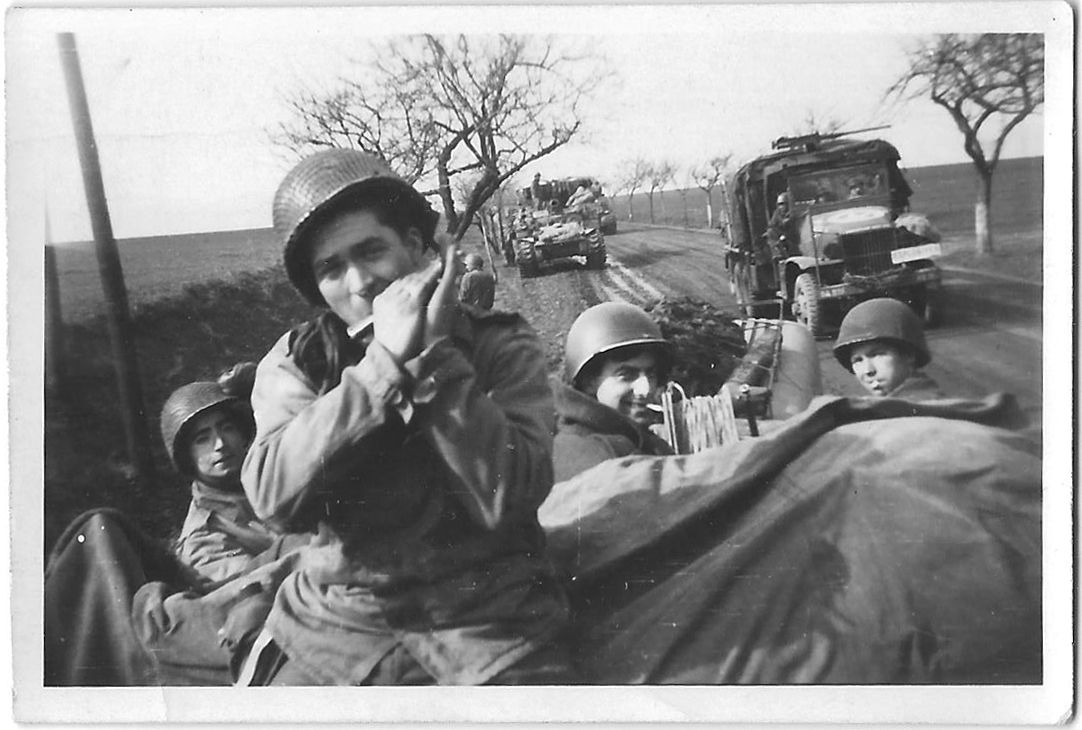
Additional comments on Picture 5:
Kline is on the far right. He was always on the switchboard. He would connect whoever had to be connected to the particular gun. Butler would call the captain and the captain would call Kline and then he would connect the captain to the gun and the captain would give orders. Col. Butler used to sometimes go up in the plane to find the target. Or sometimes the orders to hit a target would come from Corps.
The wire men had to put up poles and string wires (you can see a roll in the truck) between the switchboard and the guns so that the commands could be received from the persons telling when to pull the lanyard and stuff. The wires had to be strung so that, after firing the guns the wires did not get out of condition - it was important to get them strung right and involved various methods depending on the conditions / situation. The danger is, of course, that there may be bullets flying as you are trying to string the wires properly and sometimes stringing them requires ingenuity.
There was a 1st lieutenant and a 2nd lieutenant; the second lieutenant had to stand in front of the guns and tell them how to line up. There had to be a pole behind the tank and the 2nd Lt. told the gun crew where to put it so that, if the gun was knocked a bit off trajectory after firing the sergeant who drove the tank could line up his sights with the pole and get the trajectory right again. (The 1st lieutenant told the 2nd lieutenant what to do.)
There was also a 1st sergeant; the first sergeant would tell the captain (Foncellino) what his schedule for the day was when Foncellino called him in the morning. There was a very good 1st sergeant named Gabriel Oguayo and he had the highest possible non commissioned officer position. Something happened to the 2nd lieutenant in Charlie battery. Under battle conditions there was no way they could come up with a commissioned 2nd lieutenant. So Gabe [who had been in the Italian NY National Guard forever] knew everything about what needed to be done wherever and so was "promoted" to 2nd lieutenant. He did not want the job because he was moved from top dog as 1st sergeant to the lowest possible place in the commissioned officer hierarchy and had to do all the "dirty work"; Gerry believes that after the war Gabe went back to his original spot and by law he was not a "real" 2nd lieutenant cause he did not go to officers' school. Gerry says he was VERY good at both jobs though. Gerry says Gabe was a wonderful guy; everybody liked him.
Traveling in France, on a truck in a convoy on the road. The man standing outside is the same man who was playing harmonica in a previous picture. Gerry is next from the right, inside of the truck. He is wearing leggings outside his pants which was the proper way to wear them; it not only helped with the cold but also kept your pants from getting all muddy on the muddy roads and fields where they had to go with their equipment. Next in the picture is O'Reilly. Both Gerry & O'Reilly are wearing field jackets underneath their overcoats. It was November by this point, and cold. The harmonica player and the man on the trailer hitch are wearing just their field jackets. But underneath all the soldiers had woolen long johns and their winter uniforms.
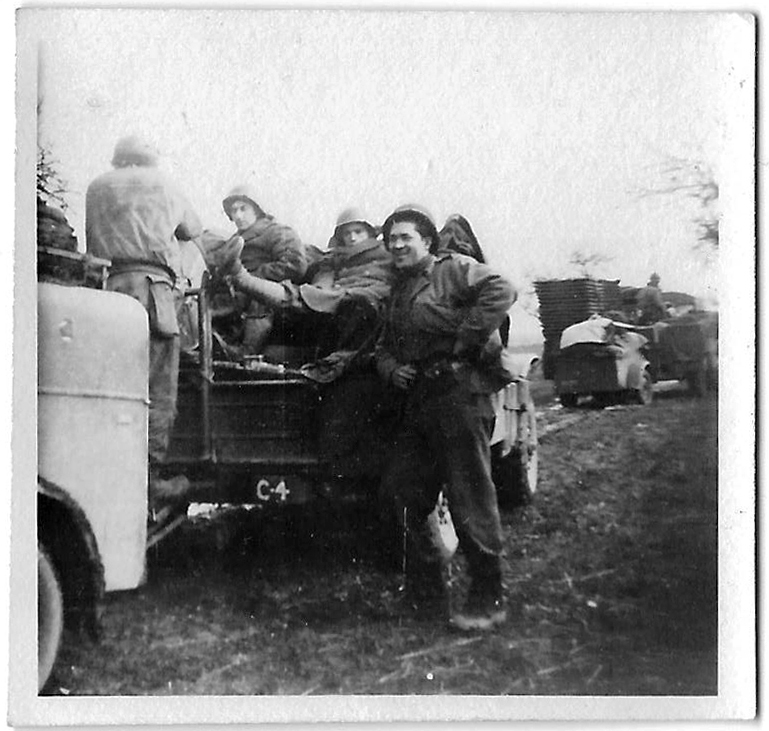
Additional comments on Picture 6:
The man on the hitch is either Kline or Armondo Esposito. Esposito came in with Gerry to fill in holes in what was a mostly Italian Guard. Esposito might have been the one taking most of these pictures since he hasn't been in them.
A trailer is on the left edge of the picture. You can see the vehicle has the stencil C-4. Gerry says that Corporal Widermann always drove the truck or he asked someone else to drive and he sat in the front passenger seat.
We don't know what the stacked items are in the other truck, but they might be supports for around the base of the officers' tent. Gerry says the 1st Lieutenant, 2nd Lieutenant, Captain and maybe the 1st sergeant even though he was not a commissioned officer all slept in the Officers' tent.
Picture in front of barbed wire at a recently emptied concentration camp.
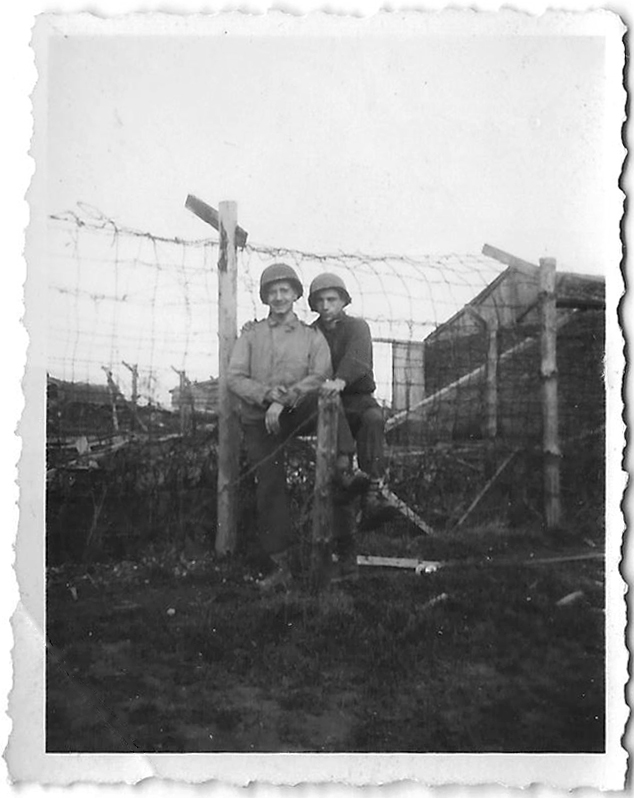
Armando Esposito from NYC is the soldier on the left in the picture. And Gerry is the one on the right. We see that the two seem to be standing between two fences. There is a barbed wire fence behind them and a wire fence upon which they are resting their left feet. You all do recall that these two are the same age. They are the youngest in the wire section. Both were 18 years old when they went into the service. In this picture both are 19 because the concentration camp was arrived at by their battery before they got 30 miles near Berlin and had to wait . It was warmer and it was late May. President Roosevelt died in April (1945). Charlie Battery was in Germany at the time and the war ended about a month after President Roosevelt died. Gerry says that Battery Charlie had to stay in place in Germany for 5 months. There were a few reason for this. This was going to be the last battle of the war; it was the Battle of the Siegfried Line; apparently the Russians wanted to be in this battle. This line was VERY challenging because it consisted of a line of cement pillboxes. The Germans were very well dug in. Also they had to stay there because the Russians wanted to reach Berlin at the same time. The Russians had had a lot of trouble because of the cold. Their soldiers and their machinery had a hard time. These concentration camps were in Germany; Gerry says that there were some in Poland also. Battery Charlie waited 30 miles from Berlin for the Russians to arrive (the Potsdam arrangement by Roosevelt/Truman, Churchill, Stalin, and Gerry can't recall the fourth man; he mentioned it earlier but it escapes him now.
The exact chronology might not be correct.
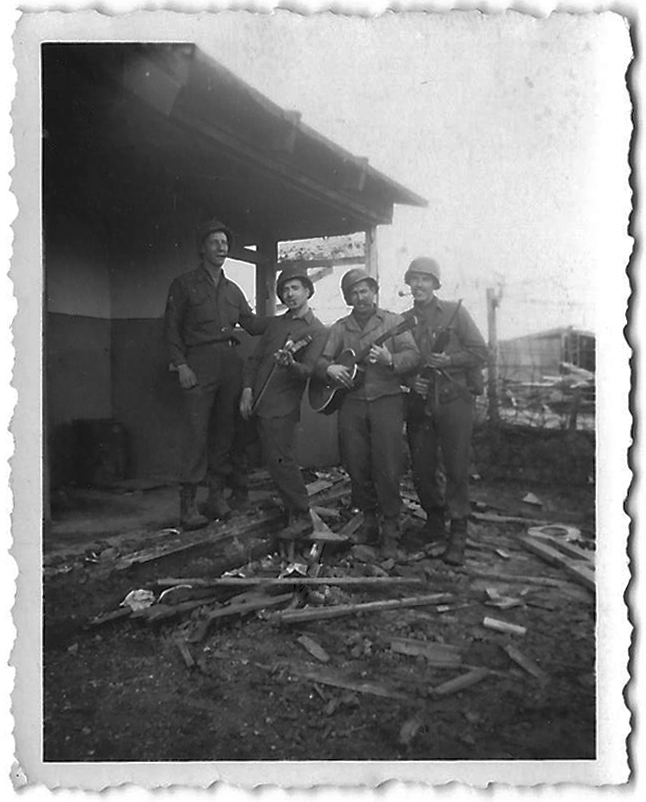
Picture taken at a former concentration camp, just emptied a week or 2 before. On the left is Corporal Widerman, head of Gerry's Wire Section. Gerry is next, with a violin he had found while they were travelling here. 3rd from left is a fellow holding a guitar, also picked up during their travels, from a bombed out building. On the right the big fellow is Lemkey, also of the Wire Center (no instrument, holding his rifle). There was a dog wandering around in front; I can't find him in the picture. Looks like they all have pipes.
The pipes were for show, for fun. None of the four smoked a pipe. The only one in the wire section who smoked a pipe was O'Reilly, but he is not in this picture.
From the right: Lemke, then the harmonica player and Gerry can't remember his name, then Gerry and then it is Witterman. Gerry and the harmonica play had picked up the violin and guitar along the way in the destruction. Gerry, of course, had played fiddle ever since he was little (no lessons; by ear). Gerry can't recall if the harmonica player could actually play the guitar. The helmets reminded me that in an earlier picture two of the men had helmets which were smooth and two had helmets which seemed to have squares; Gerry told me that the square ones the ones which the men would stick camouflage by twigs and stuff. And one of the men who had the smooth helmet was Kline because he was always inside with the radio and never needed camouflage. Gerry tells me that each helmet consisted of two parts. There was the inside liner. Then the outside steel helmet part could be taken off and used in various ways. Examples of the way they used their helmets are: wash underwear, shave, fetch water, wash up, boil water, make soup and many other useful purposes.
Gerry on a beach in Alsfeld. Other people are in the park as well. This was during the 5-month occupation when he was stationed in Alsfeld.
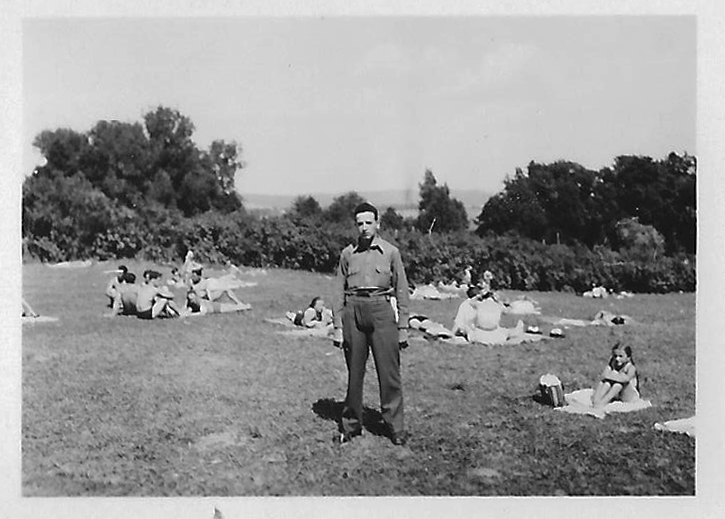
We are now looking at the picture. My first reaction is that Gerry has matured greatly. He left a boy and developed into a man. He was just about 21. It was nearly three years after he was drafted. When I mentioned this to Gerry, he said "Well, I went through a lot of bullshit and it matured me up. I went through a lot of crap that I never knew about before." IMHO, he seems glad that he survived and the future looks brighter. He is decked out in dress uniform and is looking (as usual!) king of the hill IMHO. The summer outfit was khaki and it was a dress outfit. The winter outfit was OD's and it was Olive Drab and it was a dress outfit. The other outfit was fatigues and they were cotton so they were not warm. So union suits (long johns) were underneath if it was cold. With the fatigues they wore field jackets. Basically, though, he says you wore what ever kept you warm; but he did come up with the overcoat as a winter coat for the dress outfit. That hat hanging from his belt went with the winter olive drab outfit. And in the summer the hat was khaki to match the summer outfit. Gerry says that even though everyone is wearing bathing suits he still is wearing his winter olive drab dress outfit. They were allowed to change it only when they were told they could change it to the summer outfit. Everyone had to wear the same thing and that is why everyone was "uniform." :) Gerry says it was a good time for them when they were there because they did not do anything really when they were there for five months because the war was over and there was no training or anything. Actually, he says that it was boring. There were not activities. He says it was more interesting when he got back home and went back to work. They were resting from the war and I guess for 20 year olds resting gets old pretty fast!
He said that his hair was thick and wavy (like Ted's?). Gerry actually described his own hair as curly, but it turns out he meant wavy and did not know the word. I suspect in French Canadian lingo it is one and the same!
Picture on the beach in Alsfeld. Gerry is on the left. On the right is a friend, and in the middle is the friend's girlfriend.
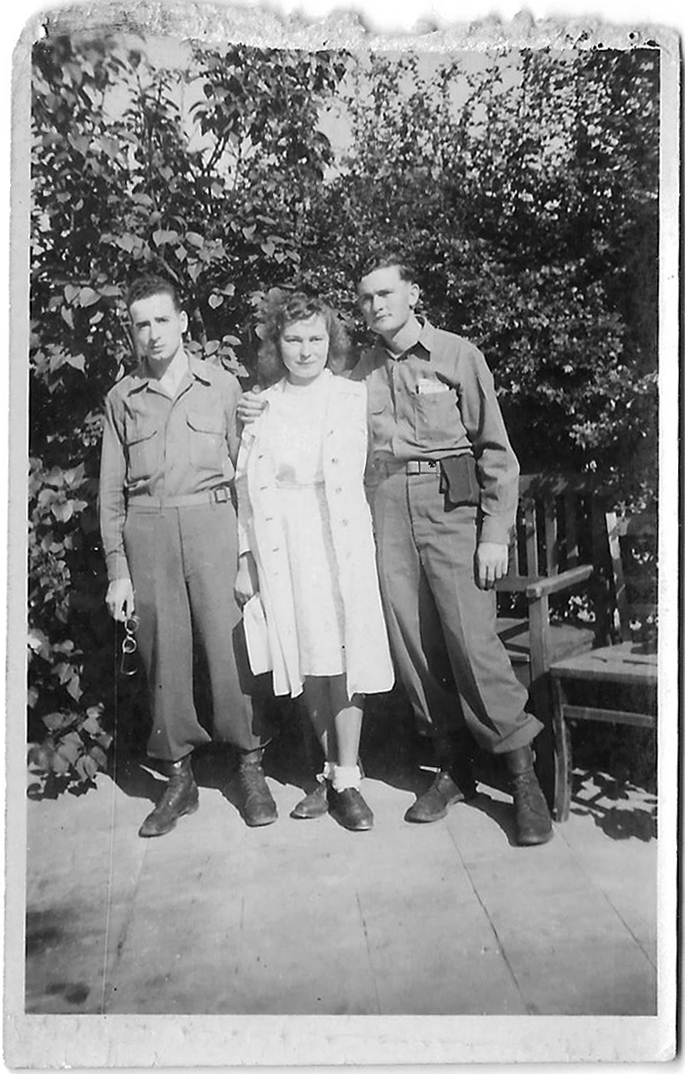
The other fellow is from Missouri but Gerry did not remember his name; he is not a member of the wire section; he is just a friend Gerry happened to be with. Gerry has no idea what the girl's name is. He says it's a German girl but that is all he knows.
Picture 11. Picture of Gerry on the Alsfeld beach, next to a woman. (There is a little lake on the outskirts of Alsfeld.)
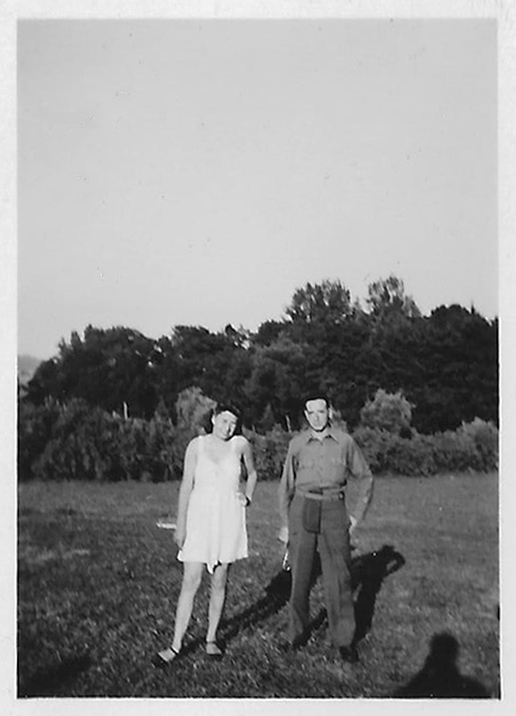
That "fabric item" on the friend's belt (and on Gerry's in picture #9) was the dress hat that went with the winter dress outfit (olive drab) and there was one to match the summer dress outfit too (khaki).
Gerry says "Notice I kept my distance!" chuckle Gerry thinks that the girl simply wanted to have a picture taken with an American soldier. At the time, there were all sorts of motivations for the women to make connections: return to US with soldier, have a baby with an American soldier, or whatever. Gerry told me the story that one soldier (the fellow who played the harmonica) told him about. While they were going through Germany, they came upon a house which was filled with 14 women. When the fellow who played the harmonica knocked on the door (Gerry thinks maybe he was seeking information), the women - how can we say it? They were thrilled to tears to see them is one way of putting it. It appears that because the German soldiers were pretty much dead or prisoners the women were pretty desperate.
Picture 12. Picture of men in front of the guns, with the guns covered by netting to make them less visible from the air. Gerry is on the right. These guns are the Long-Toms. They were a French gun, originally transported in 2 pieces and assembled on-site, and the soldiers would have to dig the guns in. By this point they had mounted the guns on a tank for more mobility.
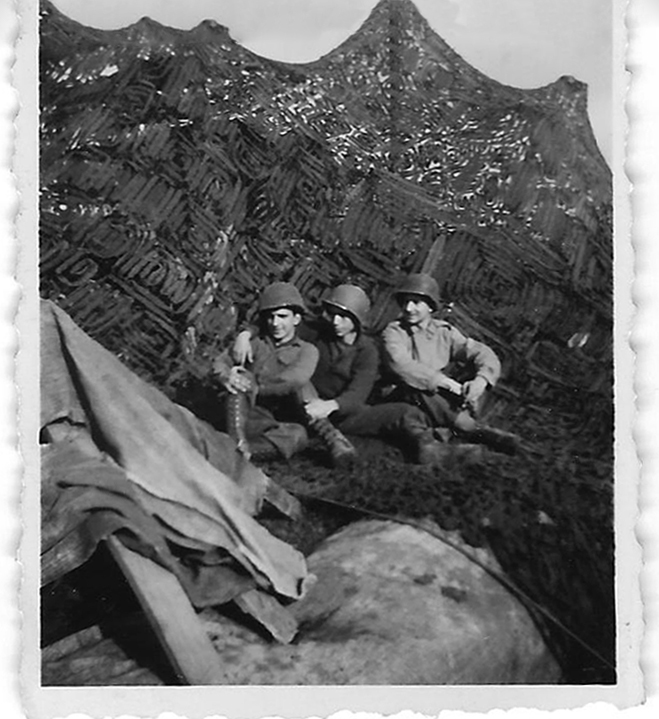
The net was, of course, to blend with the surroundings. (I myself was surprised to see how the netting was constructed because in the smaller snapshot the details can't be seen by the naked eye; this is a very good example of how important Anne's skill is.)
Gerry says "A good example of how important camouflage is" - that is what it is all about (you can perhaps note one example of the difficulty we have in "hearing" each other!
Gerry is, of course on the right in the picture. The middle fellow is our "long lost" Esposito. And the fellow on the left in the picture is Shiro.
All the men have their boots on with their pants tucked in because they had to walk through fields with mud.
Gerry was wearing all three layers (woolen underwear, shirt, and the field jacket); the middle fellow had only the woolen underwear; the fellow on the left had the woolen underwear and the shirt.
Gerry wants you all to notice the camouflage and how it is very hard to tell what is underneath - you can't tell there is a gun under it unless you already know; that is the purpose of it! The gun crew put up the poles and spread the nets over the tanks.
The canvas on the lower left may have been protecting something. Perhaps it was the ammunition. There was wood to keep the canvas as a shelter for what was underneath.
I just realized [after asking Gerry about what looks like a wire extending from the lower right up toward the middle left - and his having said that that is the border of the netting] that the men are sitting on the net. That surely was a very big net. (Gerry says "Naturally." In fact, Gerry says there was a movie a couple months ago [more or less science fiction movie] wherein a plane which had crashed into water was covered with a net so that no one would find the plane, and it took a long time for them to locate it because of the net.)
Picture 13. Picture of men in front of the guns, with the guns covered by netting to make them less visible from the air. Gerry is on the right, behind. These guns are the Long-Toms. They were a French gun, originally transported in 2 pieces and assembled on-site, and the soldiers would have to dig the guns in. By this point they had mounted the guns on a tank for more mobility. In the picture with 4 men you can see the empty shells on the right of the picture. The guns have a hydraulic breach. 72" tube on the gun. They set fire to the lanyard, which ignites the charge in the shell and sends it off, then the now empty shell recoils.
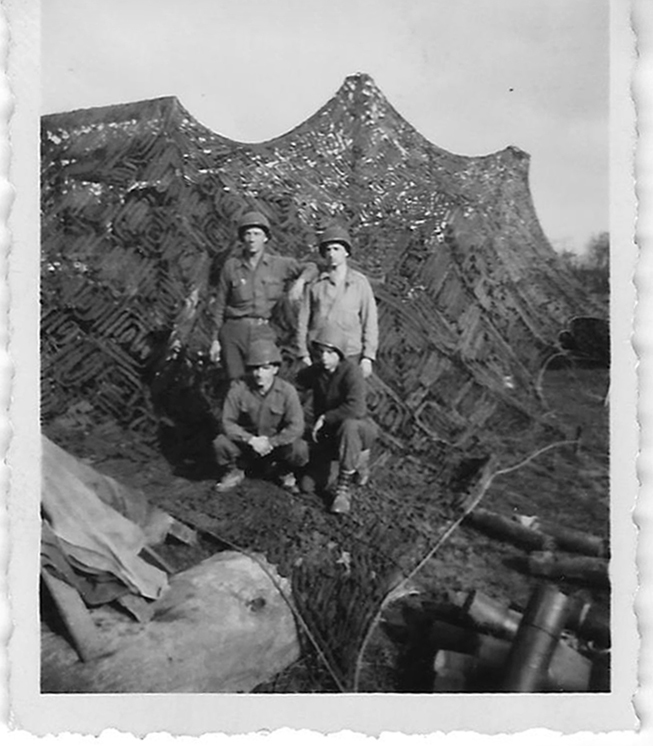
The additional man in this picture is Corporal Widermann, the head of the wire section. He is the one whose arm is on Gerry's right shoulder. Shiro was from the gun crew and Gerry says he always wanted to be a part of everything except when the guns were firing because you always had to hide in foxholes when the shells and bullets were flying.
The shells on the lower right are empty. The empty shells will be salvaged because they are made out of brass. The shell when it has its insides in (before it is fired) weighs 100 lbs. the insides of these shells have been blown into the enemy area (btw, I am the one who is forcing all this information so if it sounds odd, it is because Gerry is answering my questions). It is the same with a rifle. After you fire and then when you reload, the empty shell falls out. Somebody would pick up the empty shells and bring them back for some sort of reusing.
I am annoyed that Anne put the descriptions of the tanks and how they fire in a picture where we can't see the tanks. When we see a picture with the tanks, we can go into more detail like what she put under these.
Back to the shells and firing. I asked how many empty shells there were around. Gerry says it depends. If you get the order "Fire at will," that means that as soon as you fire, you reload and fire again; so there can be a lot of empty shells around.
I asked Gerry about the recoil and the breach and the shell when it drops out. I thought the barrel was in two parts. It turns out that it is only in one part and a hydraulic type system allows the barrel to recoil 6.' Now the shell before firing is loaded inside with a projectile which has a "thing" kind of like a fuse and when it hits it sets off the powder and the pieces (shrapnel) is what kills the enemy in the machine gun nest). Another name for projectile is the bomb inside the shell.
We have just had an extensive discussion of how the projectile gets over to the enemy but the shell stays near the gun. I cannot seem to grasp the mechanics of it because it seems to me the shell ought to go to. But that's okay.
Gerry also says that the shell twirl inside the barrel to - oops, he says the projectile swirls to give it extra force. So that might explain why the shell stays because the twirling part is not big enough for the shell. Oh, dear. This is hopeless. The twirling inside the barrel is what keeps the projective straight and on a true course.
Finally, I want to mention that Gerry says that, depending on how far they want to send the projectile they put varying amounts of charging powder inside the breach.
Maybe, if you all are "lucky," you'll get more information when we see a real tank in a picture!
The net itself is gray but they used to put the forest environment in the netting (just like in the helmets); in other words, they would pick branches or grass or leaves and stick it in the netting so it would blend and they would not be able to tell the difference that there is a gun there.
Picture 14. There are 2 pictures of Captain Foncellino's jeep. In one of these pictures a gun is mounted on the jeep; in the other there is no gun mounted. During a reconnaissance, the machine gun would be mounted for protection. Otherwise it was not. Note: during an operation, a cub plane would be observing from above and giving information to the Captain while the batteries were in motion. The captain could then direct the guns to fire using this information, and get feedback on where they hit from the pilot of the cub plane.
(#14 is without the gun)
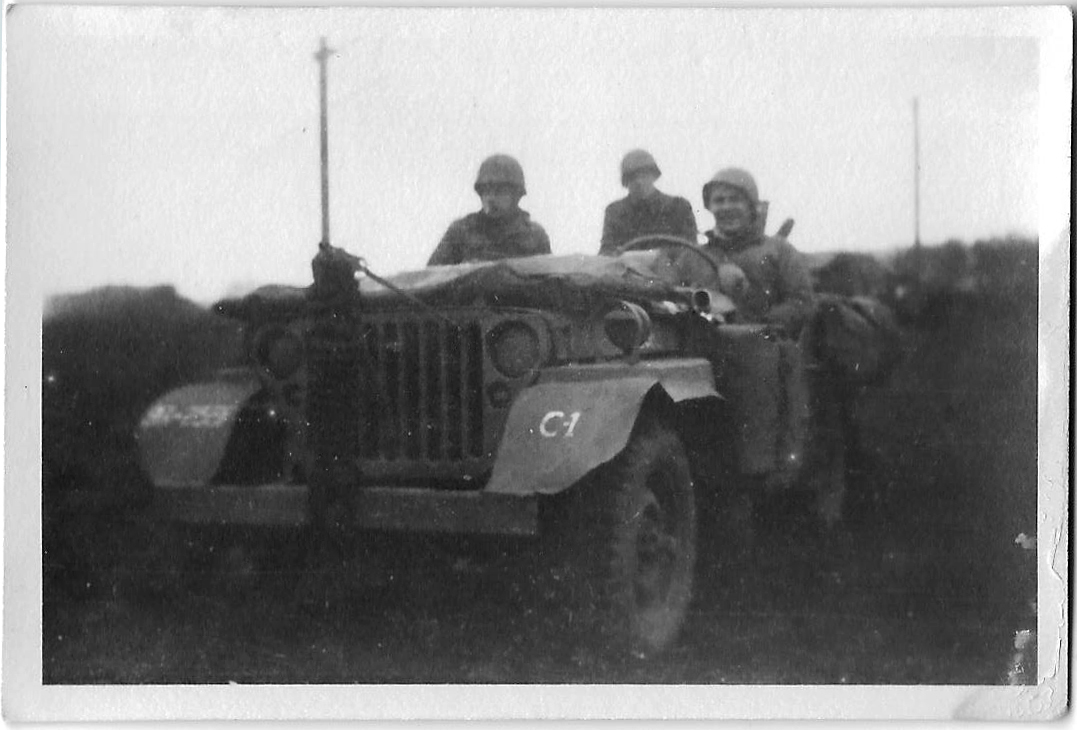
Of course, the C - 1 on the jeep tells everyone that it is the Captain's vehicle; it is the # 1 vehicle in the battery. Gerry says that the enemy would know the insignia but he says that not everyone knows that C - 1 is the captain.
The thing on the front of the jeep may have two purposes. Maybe it has something to do with hooking up the machine gun or it may be something like winch so that if they get stuck they can pull on the jeep. That there is a guess.
The lights on the jeep are "blackened" with only a slit so that when jeep and / or the convoy travel at night, the planes cannot see the light. If they know thee is a convoy there, it won't last.
Gerry says that the man in the driver's seat (Gerry is not sure of the identity of any of them) has on a winter overcoat and I suspect there is a woolen blanket on his legs besides that!
Some of the stuff which looks like baggage or whatever (maybe the stuff on the front) might be the canvas that they could put over the jeep either to cover the jeep itself or them as they are riding in it. If something comes over the radio or something and it is pouring they could put that over everything.
The man in the driver's seat has a rod like thing sticking up over his left shoulder. Gerry says it is a gun / rifle that we can partially see.
Picture 15. There are 2 pictures of Captain Foncellino's jeep. In one of these pictures a gun is mounted on the jeep; in the other there is no gun mounted. During a reconnaissance, the machine gun would be mounted for protection. Otherwise it was not. Note: during an operation, a cub plane would be observing from above and giving information to the Captain while the batteries were in motion. The captain could then direct the guns to fire using this information, and get feedback on where they hit from the pilot of the cub plane.
(#15 has the gun)
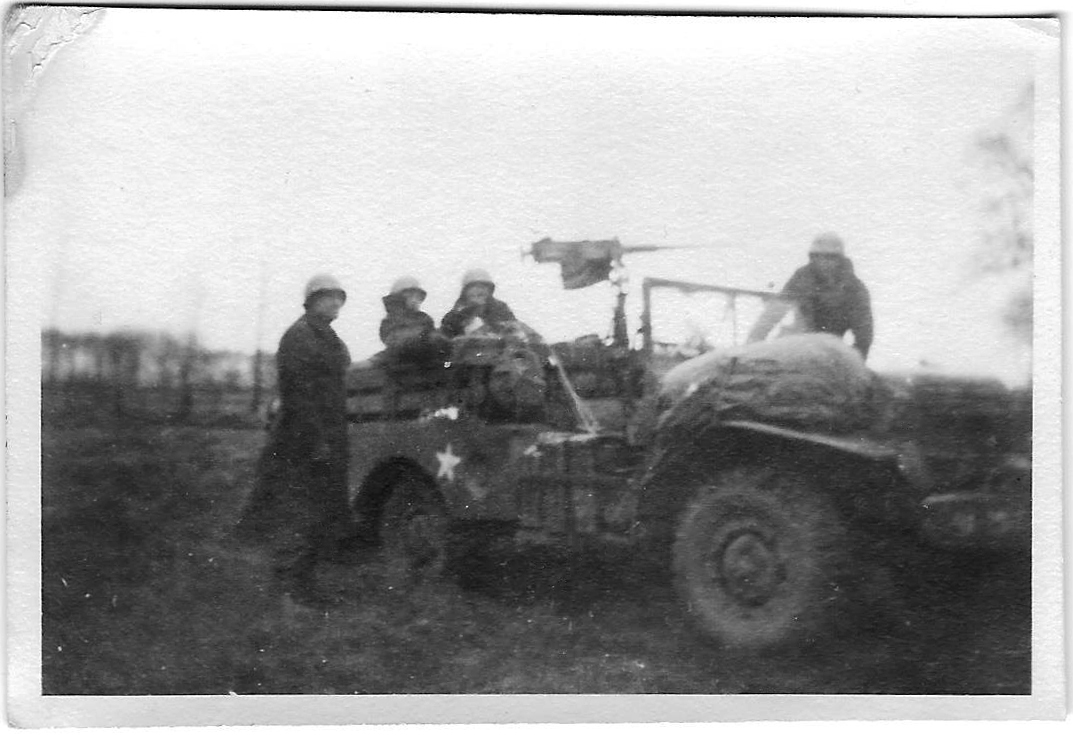
The big lump of baggage across the front in this picture is the net which they would put over the jeep to camouflage it.
The white star on the side of the jeep is the allied insignia; the Russians had a red star; and of course the Japanese had a red sun. One night we got into a position where we were, there before we ought to have been there; we were moving fast; we were caught with an air raid from the Germans and we did not have a chance to dig a foxhole or get into a foxhole and it turned out it was our own boys who were dropping bombs on us and so we had to rush outside of whatever cover we had in order to uncover our white stars so that they would realize that they were bombing their own troops. It was one of those times when we were starting to dig with our own hands because we did not have foxholes yet. Not that it did much good but we felt we had to do something.
The man standing up Gerry thinks is Schumann who was the Lieutenant and he was 2nd in command after Foncellino. the rectangular box like things which are strapped to what looks like the running board of the jeep were cans of water because they could not take a chance that the Germans might have poisoned the water. We also had something that we could put in the water if we were desperate. It may have been chlorination of some kind.
Picture 16. There is a picture of Captain Foncellino's command car (vs the jeep in the previous pictures). Capt. Foncellino was the commander of Battery C. The man standing next to the car is the Capt's driver. (It is always the same person who drives the captain, regardless of the vehicle.)
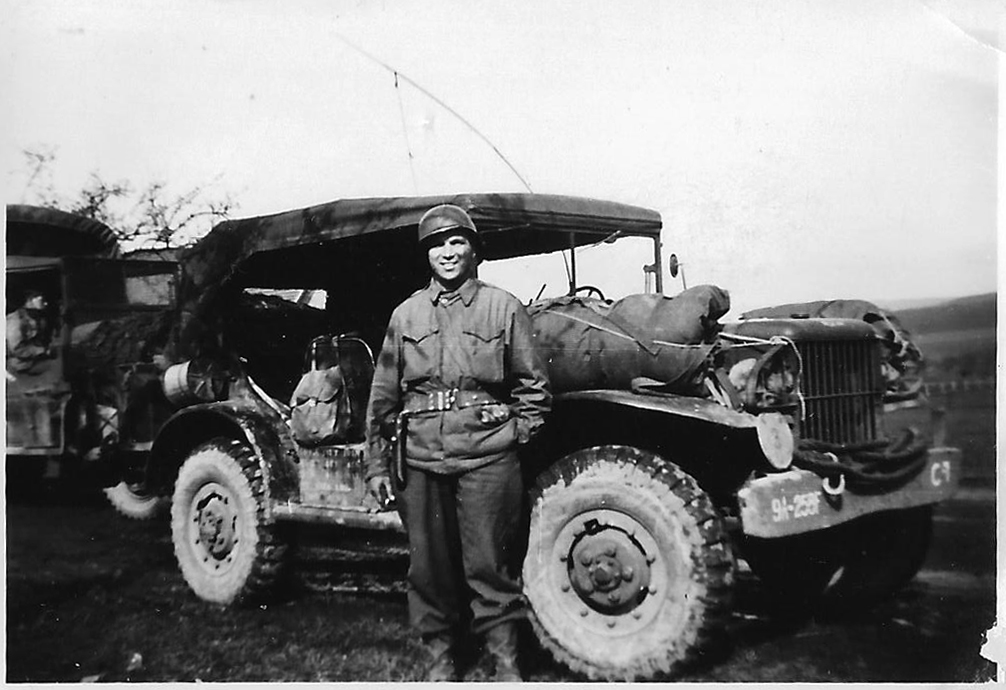
This is, of course, the command car. This was Captain Foncellino's command car and the driver was Costello who is standing there. The rolled up thing tied on the side of the car is a sleeping bag. There is a duffle bag hanging over a seat. Most of the battery soldiers had a carbine but the driver Costello could not have that and drive and he had to also protect the captain so he had a pistol in his holster. Most of the officers wore a pistol. The belt is such that usually it is to carry extra bullets in case you have to shoot your gun; it is an ammunition belt.
The tires in the picture sure are muddy; Gerry says "You never knew where you were going to land!" One time we landed in a field at night and in the morning early we found out that we were with a bunch of donkeys who were braying at daylight and that is all the soldiers heard was the donkeys and they woke everybody up but it was daylight anyway and they had to get started on the day anyway.
It is very clear that there is a rope and a hook on the front and if it got stuck a big truck would pull it out. Gerry says it would have been a metal cable if it is a cable. The command car is big and heavy and it could get stuck.
There is of course and antenna sticking up like a fishing pole because the captain has to have radio contact cause he is in command / charge and when the cub plane in the air which is reconnoitering needs to have radio contact with the captain so the captain can do the commanding. Gerry says that the cub plane was a very light plane and if it had trouble it could safely land in a tree!
On the back fender Gerry thinks the roll is a roll of wire.
Gerry says that the top on the command car was always up whenever he observed because 1. there is radio equipment inside and 2. the captain does not want to be seen too much either.
The truck behind looks like a regular troop truck. The battery is traveling on the road at this time so it is a regular convoy.
Gerry says that this road is rutted.
Picture 17. Gerry's brother Fernand (Fern) in his Infantry gear, standing in a field. Fern has his canteen, a rifle on his shoulder and a cartridge belt. All the soldiers had canteens and rifles. The infantry primarily had Garand Rifles or Enfield Rifles. These both had 1 shot, and then had to be reloaded, hence the cartridge belt. Gerry's battery had Carbine Rifles, which held 15 shots. So Gerry did not have a cartridge belt. The canteen was obviously so that they could carry a beverage. They did not trust the water, and so filled with canteens with cider - hard cider, generally. The canteens would turn black inside eventually.
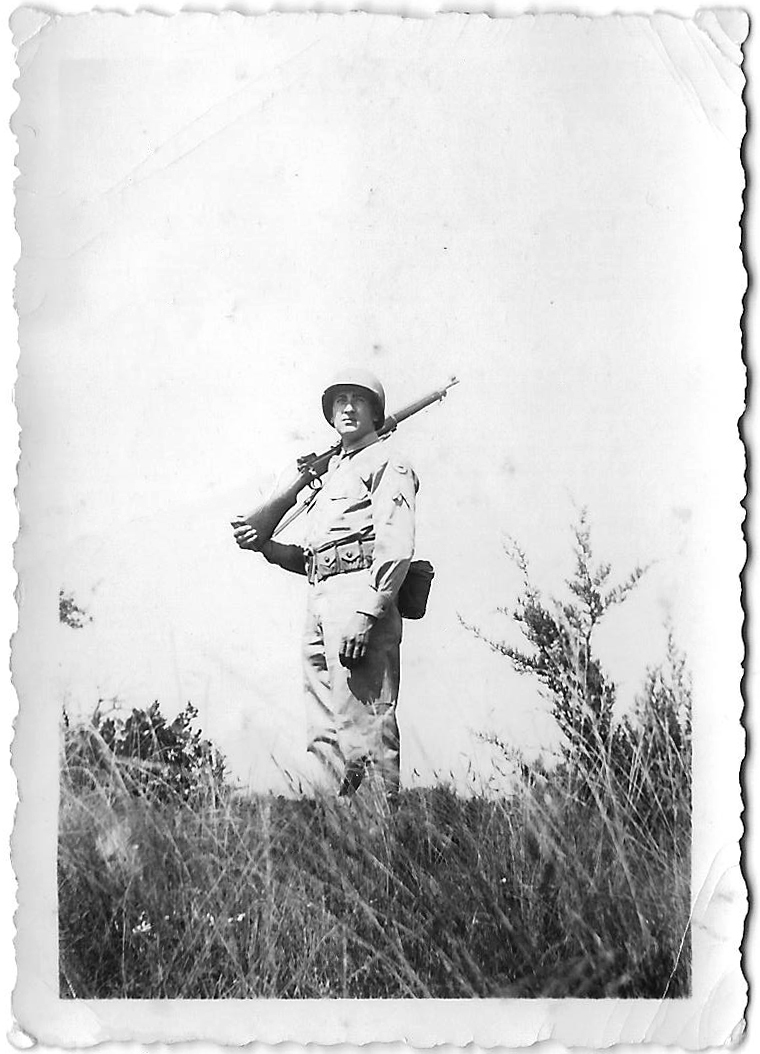
Links with more information on the types of rifles:
The rifle of the infantryman was heavier than the carbine; it was made of heavier wood; it had a heavier metal barrel and also they could add a bayonet to it; the shot from an infantry rifle was more accurate and the rifle had a sight and the barrel was longer to make it more accurate.
Picture 18. A picture taken in Alsfeld of one of the battery's guns, which was named "Corregidor" (?). Battery C's guns were all names with names starting with the letter C. Corporal Widerman is on the right (the head of that section). A fellow named Shiro is on the left. Shiro was a regular member of the NY National Guard.
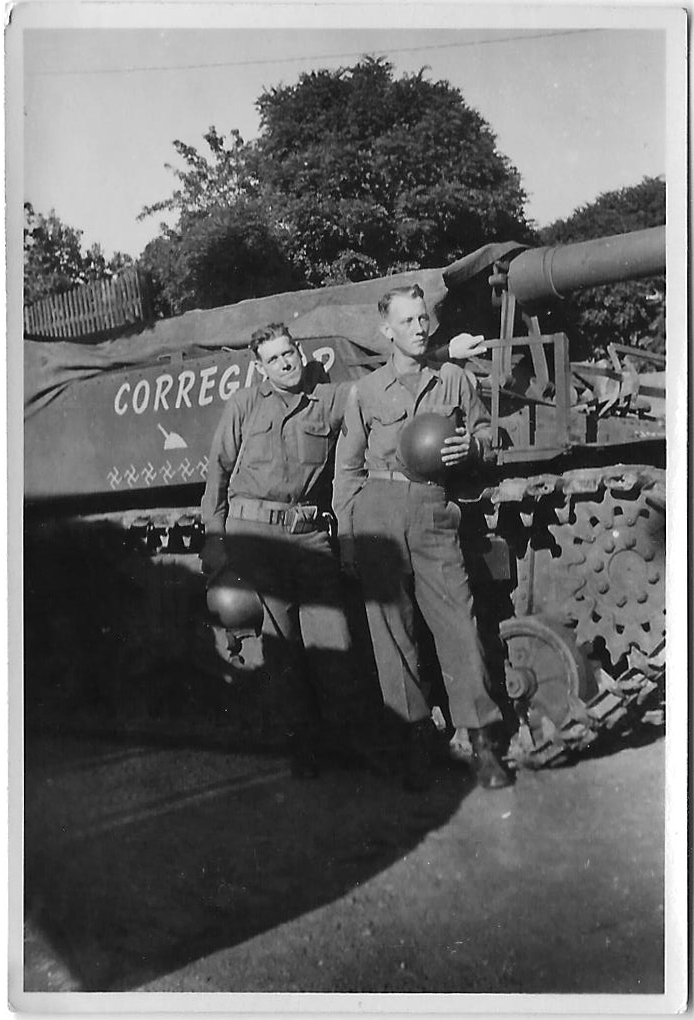
To me, Shiro looks like Kirk Douglas! The tank is quite clean! Gerry says the guys had to clean the tanks when they were able because the guns have to be kept clean and you don't want to turn in a tank until it's clean. The swastikas on the side are similar to other tanks or planes which used to put a symbol for the number of known hits (machine gun nests?) on the enemy - and putting that target out of commission.
Widerman is so different in looks from Shiro. Shiro is Italian from NYC. Widerman was from Kansas or maybe Arkansas, Gerry says. You can see the regional immigration genetic heritage in both to a large extent.
Picture 19. One of the guns, and it's crew.
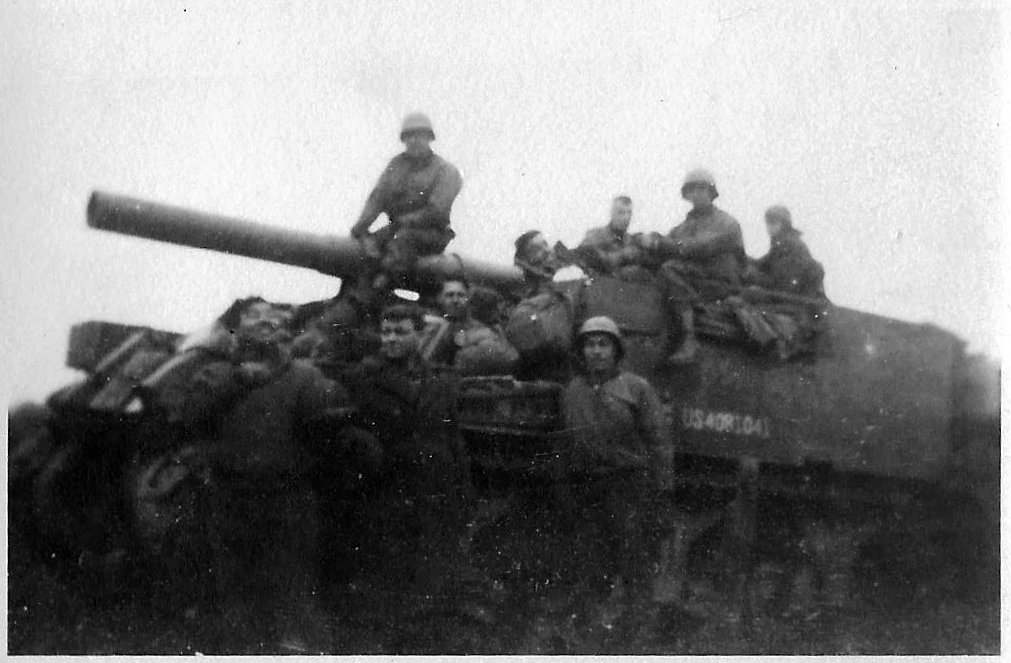
I noticed immediately how much bigger the barrel is than I have seen in any of the previous snapshots! There is a man sitting on it and the contrast points out the very large size of gun and equipment. Gerry pointed out that there is nothing polished in this picture. The crew and the gun on the tank are combat ready. This is what he is emphasizing when he says "This is a war picture."
I asked about the bag hanging sort of in the middle. Gerry says, "It's like I said, there's everything there in that picture."
The man standing on the ground sort of in the middle and by himself pretty much is O'Reilly from NY (it appears that more than one section got into this picture).
The fellow whose head is touching the gun in the picture and who is under the fellow sitting on the gun is likely Lemke.
Second to the right hand side on the tank Gerry says "If I had my guess, it's Kline."
Apparently Lemke and O'Reilly (and Kline) are in the middle of the picture and they are from the wire section; Kline was from Tennessee. He used to be called "hillbilly." He was telling us a story and he said "it was so funny, we laughed so much, we lak to dah!" (This spelling is supposed to be a "Tennessee accent.") The rest of the men were gun crew and they had to have been in Gerry's section because otherwise the wire section (where Gerry belonged) would not have been in the same picture.) I said to Gerry that the gun crew looks pretty rugged. He said they had to be and besides that they had been in the army for a long time and they were seasoned.
Picture 20. A picture of one of the tanks firing during the day. It is again covered by a netting to make it less visible.
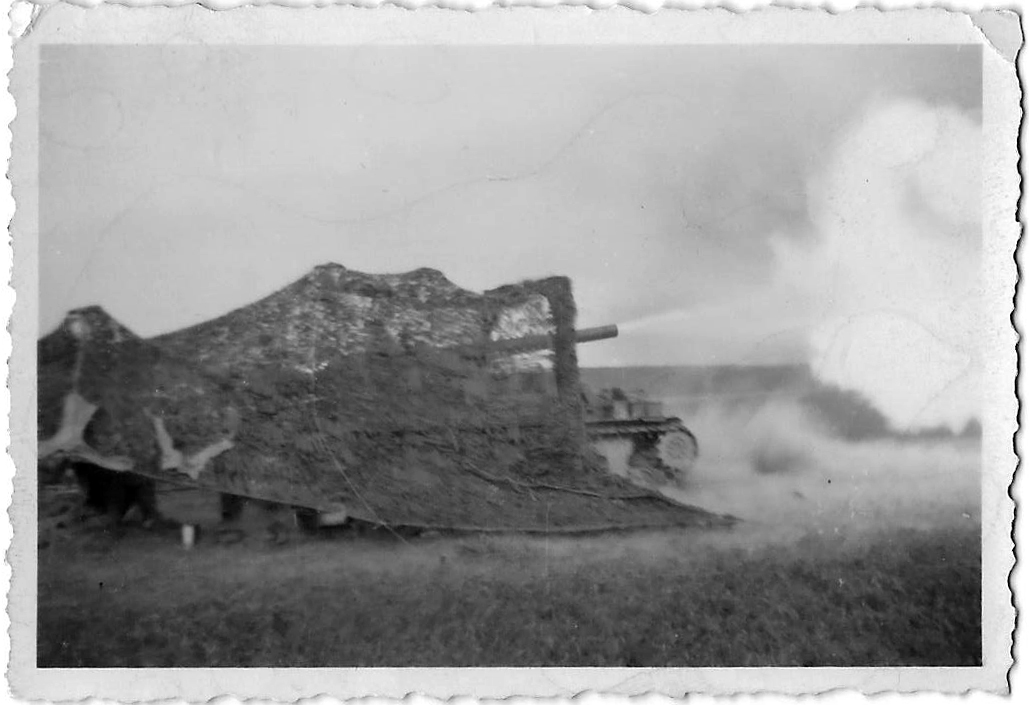
Picture 21. A picture of all 4 guns of the battery firing at night. They had flash-reducers that would be used at night to help make the positions less obvious.
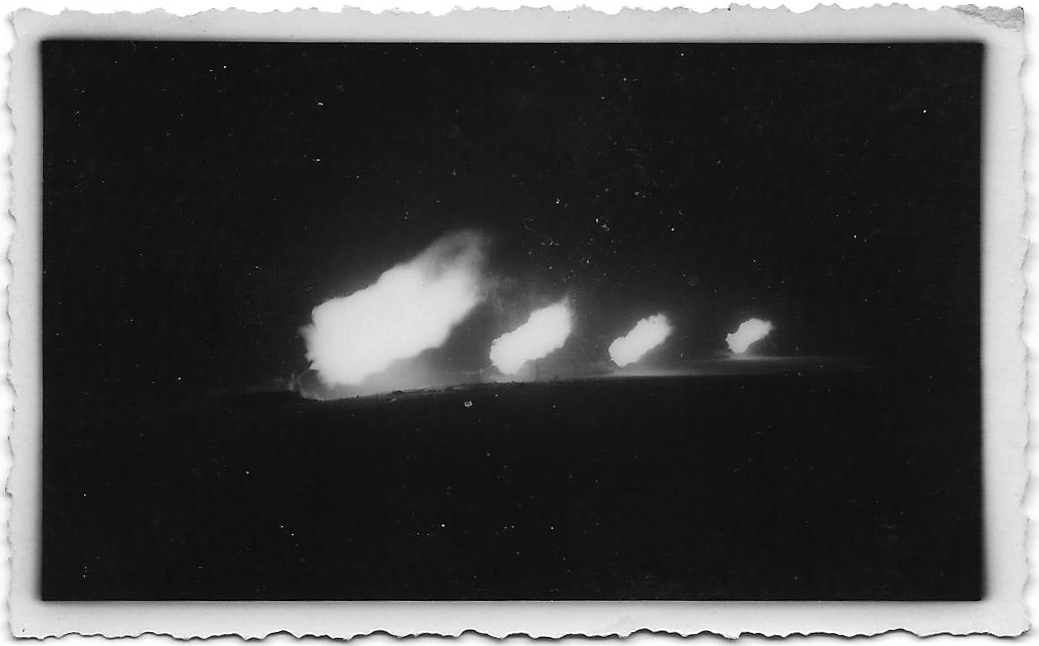
It is pitch dark out there and so it naturally is bright looking. Without the light reducer, it could be seen from 20 miles away and they could pinpoint us with it. The reason we were not allowed to smoke at the front is that they could see the cigarette from a plane above. I asked Gerry something like "It's really bright when it fires?" His answer: "Just imagine when it's pitch dark and you put that fire out there; it's not too hard to figure." "There's no lights out there whatsoever, even in the streets; no nothing."
Picture 22. picture of the 4 guns at rest, after the war during the occupation. This is in a grove in Alsfeld. The guns are covered with a tarpaulin.
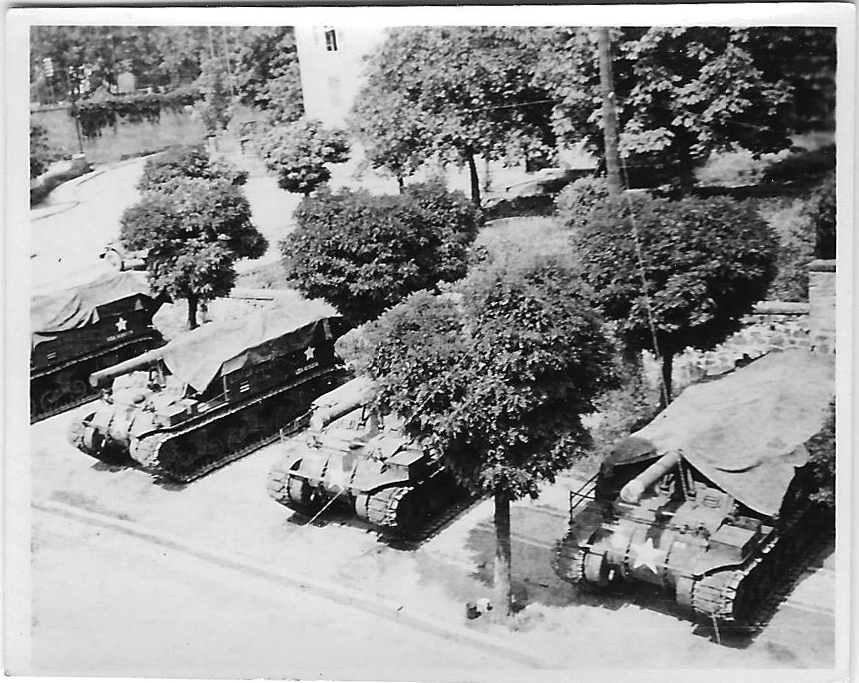
Now we are doing picture #22. Apparently I made a boo boo when I said hydraulic breach. It is a hydraulic recoil. And since the guns (long Toms) had been put onto a tank, they were heavy and when the long Toms were fired they were anchored by the weight of the tank so there was no longer a need to dig the guns in before firing. We were also able to get out fast and we were able to use the guns as an assault weapon on a target and get out before they could pinpoint us; that was not possible when they were dug in. Gerry says his was the first outfit get the guns attached to tanks. Another misspeak: it was a 72" recoil, not a 72" tube. Another misspeak: the charge is not in the shell, it is in the breach. The shell is to only cover the projectile (like in a rifle, the bullet is in a cartridge and the cartridge stays back after the bullet goes and the cartridge falls out onto the ground near the rifle. In this case the cartridge / shell comes out after you open the breach. there is powder behind the shell to send the shell and there is powder in the shell to power the projectile out to its target. It is a matter of weird physics to me that the powder behind the shell does not push the shell too! anyway after the powder behind the shell explodes, it ignites the powder in the shell which sends out the projectile and then when It land where it hits supposed to go there is a fuse which ignites and explodes the projectile which sends shrapnel all over the place and kills the enemy and wrecks everything in sight.
As Gerry just mentioned, it is hard to get a better picture of those tanks than in picture #22; of course it would be better if they were not covered with a tarp but that barrel on the 2nd tank from the left is certainly impressive. And the treads on the tanks are mighty impressive too. Those are BIG tanks. I did notice that there is a cap on the end of the barrels so the dirt does not get in because those guns have to be cleaned, Gerry says.
Those are BIG tanks; note the one on the right. I don't think I could even wrap my arms around it - never mind lift it up! Looks how far back it extends too. Well, I guess that's it but those tanks are SOMETHING ELSE!
Amazingly, usually there is only one guy in the tank. But when it is used for combat a tank has slits around the tanks so you can fire from them. But these tanks were made for a different purpose and when the gun is to be fired everything is done from the outside and there is no one in the tank.
Gerry commented many years back that, when he got on the radio (with his heavy {at the time} French Canadian accent), they would say "It's that lousy Frenchman again!" :) chuckle (I don't think I would have enjoyed that very much.)
Gerry also used to comment that the army usually [and seemingly deliberately :) ] put a man in where he ought not to have been put in - into a place where he was not especially suited to be.
And, besides that, he said that at the induction center, they would ask where you wanted to be placed; if a man answered "artillery," they would stamp "infantry" - or whatever the particular exchange happened to be. So Gerry answered that it did not matter to him. So they stamped "Artillery."
In this unit (the Battalion) there was a Headquarters section, and three firing batteries (A, B, & C). Each of the three firing batteries had its own radio section and its own captain. Three firing batteries had the same make up but headquarters was different. The headquarters was what provided the materials for the kitchen and the paper work (headquarters kept the records and did the paperwork and everything was really directed by the headquarters battery). But every battery had its own cook and "kitchen"; remember Gerry saying that, when they went through France, if there was a cow in the field in the evening, it was not there in the morning! The head guy at headquarters who was in charge of the whole battalion was Colonel Butler.
A comment Gerry made tonight: he said that they used to call Col. Butler "the old man." I'll wager Butler was a lot older than Gerry's peers!
When the battery was in transit there was no special way to dress. When they were moving around was different from when in the barracks and everyone had to wear the same thing. Fatigues is what the clothes were called when they did the work in the fields. The regular uniforms were called OD's; that means olive drab. That is the regular dress uniforms. Towards the end of the war, they did away with leggings. [The battery started out its time in Europe wearing leggings though.]
Gerry brought up his discharge paper because, as part of the review of his WWII experience, they are a kind of summary.
The front side is the formal statement of Honorable Discharge presented to Gerry on November 4, 1945 at Camp Edwards in Massachusetts by Major Robert L. Todd.
On the reverse there are details such as the fact that Gerry's position in the army is that of Field Lineman 641. He was issued an MM Rifle and an MM Carbine. He was issued a Good Conduct Medal and a Europe Africa Mideast Camp Ribbon with 5 service stars. The information includes that Gerry left on January 22, 1944 for the European Theater of Operations. Gerry arrived back from WWII on October 30, 1945. It took him 6 days to go over on the Queen Mary and 9 days to come back on a Liberty boat. The Queen Mary could do 30 knots but the Liberty boat did 18 knots.
Gerry did 8 months training in the U. S. and he spent 1 year and 9 months in Foreign Service. Gerry's colonel, Colonel Butler, wanted to keep the entire battery together so that the entire battery would be discharged simultaneously in New York. Colonel Butler felt very fatherly toward his battery and wanted to keep it together. Gerry, however, had enough points to be able to make his own decision and so he was discharged from Camp Edwards in Massachusetts.
The battles listed as part of the information do not include the Battle of the Bulge as such because Gerry's battalion served only as back up at the Battle of the Bulge so that they never actually fought in it; they were there but only in reserve. The following are the five battles and campaigns in which Gerry is listed as having participated [on the back of Gerry's discharge paper]:
- Normandy
- Northern France
- Ardennes
- Rhineland
- Central Europe
These campaigns took in France, Belgium, Holland, Luxembourg, Germany.
Gerry says that the autobahn was there when he was there 70 years ago. He says the Nazis built and it was pretty new. It was a very good road and it had four lanes. I t was as good a road as any we have around here in the states. Okay, I just googled Berlin to Aldsfeld and found out that it is 216 miles. It is pretty much 3 /4 of the way from Berlin to Frankfurt. Very interesting. I asked Gerry if he ever actually went into Berlin and he said no that his battery stayed 30 or so miles away from Berlin. And then when they were told to occupy Aldsfeld they went back 186 miles SW from Berlin. And they stayed there for five months. Gerry says that they used to listen Radio Luxembourg (with a French pronunciation to the words, of course, and the broadcast in French and the voices were deep male voices and Gerry could understand all the French). Gerry says he was attached to the 9th army. General Bradley, he thinks, was in charge of the 9th army. Gerry says that when it was time for his battery to be back up support at the Battle of the Bulge, his battery had to travel all night in order to get to the border and being part of the group which fought the battle in three countries (from what he can recall it was fought in Belgium, Luxembourg and France). Gerry's batter had to go up north from a more southern battle ground (disguising the fact that they were not there) in order to get to the location of the Battle of the Bulge. They did take a train before that to go to Nice for a vacation. He cannot recall where they left from nor how long the train ride was. He does recall that he stayed in the Hermitage hotel which was in the mountains or hills outside of Nice. Gerry also took a vacation in Paris. He thinks that they went to Paris by truck. He thinks that they were not that far away from Paris on this one. Gerry says that Switzerland was not that far away when they were told they had to go for back up at the Bulge. In effect, it seems that they almost had to back track (sort of NW), which, of course, makes sense because the Bulge was a total surprise; no one expected it. I googled the map of the Battle of the Bulge and way over on the left of the map is "2nd armored division" and Gerry says that once in a while they used to call for extra power from our units to get a certain area softened up so that they can push forward with the infantry.
re the Hermitage Inn in Nice:
Gerry says he figures that the French government footed whatever bill there was. He only remembers the color of the cognac. He does not think they were near Monte Carlo. He says they left the Promenade des Anglais and went up a hill / mountain and that's all he can say. But he says it was in Nice and he does not think Monte Carlo would be in that section there. Of course, when he was there, there was no gambling in Monte Carlo because it was war so he would not have known what it was supposed to be. He says they were just there because it was a refuge for the soldiers. It was a very foggy place because they went there and they drank - it was foggy because they could not see straight. This is terrible. He says they drank cognac and champagne for a chaser. Cheez, I am sorry I asked! He says it is another angle to say that he does not remember exactly what the environment was. He says they never went on the beach! He says they did not go there to swim. Tell that to Liz and see what she thinks of it! The only thing that seems to be clear to Gerry is the Blvd des Anglais because he was sober when he arrived! And he remembers going up the hill / mountain. What a waste of Nice! Gerry says it is like some conventions like Archie Bunker and they get into trouble because they get kind of intoxicated. They went there to forget Gerry says. Dear, dear dear! I don't think that he is the same kind of fellow now. I sure hope not.
While we were having lunch on Gritty's deck, a yellow jacket was checking out our food. Gerry remembered that, all the time they were going through Europe, they were very much annoyed with tons and tons of yellow jackets so that they could not eat peacefully at all. They finally put a bunch of marmalade at a bit of a distance away from where they were eating and the yellow jackets went there and at least let them eat.
In reference to the Wikipedia pictures of the long toms:
It was a new picture for Gerry also because he never saw one dug in before. He says that the man standing in the center with a white bent thing is holding a cradle for a shell. I noticed that the gun is in a hollow that is surrounded by a lot of dirt at least on three sides and I mentioned that that was lot of work to fix up that sort of protection and Gerry said yes, that was the problem that it took so long to get the guns situated and they were not very portable. The cradle for the shell goes to the breach because the shell before firing is very heavy and two men carry it in the cradle so they can push it into the breach before they shut the breach and shoot it.
Gerry says that is about the best picture you can get of it because it is clear and clean! (not muddy) I noticed that the nickname on the side of the tank is "Big Shot"; Gerry says that likely it belonged to B battery; the nicknames for the guns in his C battery began with a C.Gerry also said though that those working back home in the war effort got paid more than he did! I guess we thought that was amusing (sort of) but I added, well at least you had room and board. And that was pretty funny because the food often could not keep up with the troops so they had "dog biscuits" and their rooms were foxholes! I said well, at least you knew what group your home was located with and where at that particular time. [Anne, you might want to get Gerry to say something about that food not keeping up with the troops.]
Updated August 2020